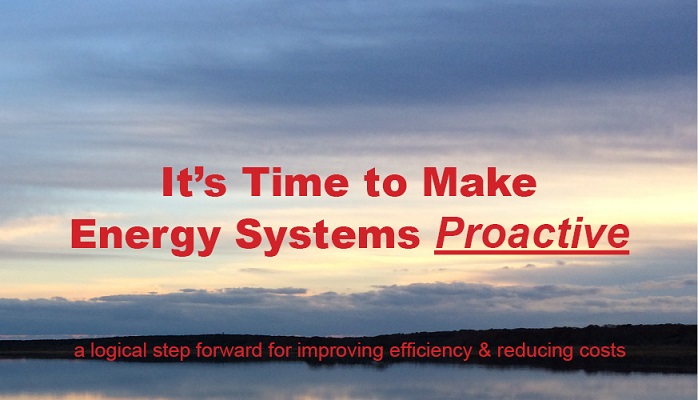
Making energy systems proactive is a logical step forward in improving building energy efficiency
Proactive building energy systems can increase energy efficiency, improve comfort, lower energy costs, reduce peak energy loads, and increase property values.
What is a proactive building energy system?
A proactive building energy system uses forward-looking input factors such as a building’s thermal momentum, near-term weather forecasts*, and demand costs to help determine system outputs. Artificial intelligence (AI) software uses strings of data inputs and self-learning to calculate outputs and optimize system performance.
A proactive energy system can be an add-on part of a very basic system, or it can can be integrated with a complex building management system (BMS) using open protocols or something else.
Contrast with today’s reactive energy systems
Nearly all building energy systems in North America today are reactive. A typical example would be a temperature set-point being reached which triggers a relay that starts or stops one or more devices (e.g. pump, boiler, chiller). There may be a variable component to the output, such as a distribution temperature selected from a heating curve. Commonly, a PID control determines the targeted output . The production and distribution technologies themselves (e.g. condensing boilers, variable speed heat pumps, low-temp hydronic distribution, etc.) may be high efficiency in a stand-alone sense. Nevertheless, they are limited by the narrow range of input data that are available to them.
Key differences between reactive and proactive system control
When external factors are changing quickly as is typical with nearly constant changes in weather factors (such as temperature), or when demand rates kick in, the reactive system loses its ability to optimize energy inputs.
Proactive energy systems on the other hand, use a range of data that includes forward-looking data that feed dynamic algorithms. With proactive systems, there can also be some automated learning involved as improvements build on past improvements. This is where AI can play an important role. The AI is used to determine thermal inertia and thermal momentum, both of which are important for maintaining targets without over or under performance. Reactive controls don’t have this ability.
Fortunately, there are more similarities than differences. Proactive systems and reactive systems use the same building assets. So from an upgrade perspective, it can be very easy to make the change.
Examples of proactivity in our lives
Although you may not have thought about it in this way, being proactive is a natural part of our everyday lives. There are countless examples of being proactive that illustrate this point.
Here are a just a few examples from one thing many of us do every day: drive a car. Imagine you’re behind the wheel of your car and you’re driving down the  road. You see a sign that says “Stop Ahead”. This is an opportunity to be proactive. You can take your foot off the accelerator and let the momentum of the car carry you forward to the stop line. That’s proactive and saves a little bit of energy. Now imagine you’re on a highway and you see a sign that says “Exit Right 1 Mile”. If that’s your exit, you can look for a good opportunity to move over to the right lane. That’s also being proactive. A third example is when you drive with your high beams on at night, you’re gaining more “visual data”; you can be more proactive in dealing with upcoming road hazards.
road. You see a sign that says “Stop Ahead”. This is an opportunity to be proactive. You can take your foot off the accelerator and let the momentum of the car carry you forward to the stop line. That’s proactive and saves a little bit of energy. Now imagine you’re on a highway and you see a sign that says “Exit Right 1 Mile”. If that’s your exit, you can look for a good opportunity to move over to the right lane. That’s also being proactive. A third example is when you drive with your high beams on at night, you’re gaining more “visual data”; you can be more proactive in dealing with upcoming road hazards.
Of course, being proactive doesn’t necessarily have to lead to greater efficiency. Proactive measures in energy are worth doing if they help achieve an objective like lower energy use, lower demand charges, or higher comfort.
Thermal momentum quantified and used proactively
Being proactive helps increase efficiency in cases where momentum (including thermal momentum) and inertia are significant factors. Thermal momentum is identified and used by AI for proactive control.
As momentum is the product of mass and velocity, higher mass leads to higher momentum. As an example of this concept, heavy trucks benefit more from that “Stop Ahead” sign than does a car, and the car benefits more than a bicycle. A pedestrian may not benefit at all. So the greater the mass, the greater the momentum, and this is true in buildings as well. Proactive AI control can account for momentum and inertia, and use it to improve overall efficiency.
A multifamily building is full of walls, floors, ceilings, carpeting, furniture, and plumbing. Therefore it is relatively dense. An empty airplane hangar, a big space filled with nothing but air, is not dense. As a result, changes in thermal energy can occur much more quickly in the hangar (assuming the building size, energy systems, and building envelopes are equivalent). Because the multifamily building is denser, it takes longer to heat up, and is slower to cool down. All that mass inside the building is a heat sink. That mass is absorbing and radiating back out thermal energy constantly. If a heating system reacts to a set point being reached, and stops pumping heat into the building, that building mass will continue to radiate heat back into the living space. If the outdoor temperature rises or sunlight streams in, the interior of the building can become overheated.
Consistent building temperatures with proactive control
Another thing we can say about the multifamily building is that steady temperature is important to the people that live there. Zeroing in on a set point temperature is a challenge that is easier with AI and proactive control. Multifamily building owners know that the alternative to consistent indoor temperatures is either complaints, open windows in winter, or both. It also can lead to higher energy costs, increased tenant turnover, and lower rents.
Lowering demand peaks in district energy with proactive control
In cases where there is an energy demand rate**, it’s possible for a proactive energy system to optimize operation to pre-load heating or cooling, and to hold back from the high demand peaks that drive demand charges. As noted earlier, this is a valuable tool where building mass can be used to advantage. This is most common for buildings connected to district energy networks, but is evident in other energy scenarios as well.
Other applications for proactive energy control
Besides thermal energy, as described above, there are other forms of energy consumption that can, and sometimes do benefit from proactive control.
- Natural gas consumption
- Electrical power (demand response)
- District energy (heating or cooling)
- Chilled water /sensible cooling
Back to top of post
*useful weather data may include the timing of upcoming temperature, sunlight, wind, and precipitation.
**energy demand rate – charged by some district energy utilities and electric utilities. Demand charges may be tiered, and can vary by time of day and time of year. In some cases demand rates change daily, with a day or less of advance notice. Demand charges help utilities pay for the higher marginal cost of supplemental energy sources, or the cost of infrastructure needed to meet peak demand.
© 2019
The Point of Being Proactive
Proactive means forward-looking. Humans are naturally forward looking. We plan ahead; make budgets, plan our days, plan our vacations, plan for retirement, and so on. We do this because we know that the alternative to being proactive, which is being reactive, leads to less desirable outcomes (e.g. “Oh, today is my vacation, I think I’ll go to the airport and fly somewhere warm!”). 
Most of us learn this by the time we are in high school. We’re able to be proactive because we’re capable of thinking ahead, and there’s usually some data we can use to help us plan ahead. We look at movie schedules, flyers for school plays, announcements of sports events and the like. All that foreknowledge is “data” that we can use to plan our lives.
We also use weather forecasts for some personal energy-related planning.
- We bring along a hat and coat if we’re anticipating wintry weather.
- We close our windows if we’re expecting rain or cold.
- We close the window shades if we’re expecting a lot of sunlight on a summer day
So the point here is that being proactive is natural, depends on data, and usually leads to more desirable outcomes than is the usually the case for the alternative.
Please read the post titled “Time to Make Energy Systems Proactive” for a closer look.
Reducing energy use in buildings often requires an investment of capital, making an obligation of some sort, or both. As with any investment, there needs to be an acceptable financial return.
Returns are usually quantified in dollars saved. When looked at strictly from a dollars point of view, the investment can be looked at like other investments. The investment might even be compared to alternatives such as repaving a parking lot, expanding a workout area, or hiring more staff. Except it should be easier to quantify the return on the investment in energy reduction. Energy consumption can be easily measured. Things like parking lot improvements and staff may be desirable, but the returns are largely guesswork.
Payback Period
One of the easiest ways to quantify energy reduction return expectations is by estimating a simple payback period. Divide the expected annual savings by the initial cost. If an expected simple payback period is really long, like 15 or 20 years, that investment can be quickly eliminated from contention without spending any more time on it. There are probably alternatives out there that will get a much faster payback.
Limitations to payback period as an investment metric include not quantifying changes in maintenance costs, which are not part of the initial investment. Also not accounted, but very significant are the returns that accrue after the payback period ends. The time value of money is not accounted for.
Discounted Cash Flow Analysis (DCF)
Discounted cash flow accounts for the time value of money, and is therefore a metric that can be used if the quick-and-easy payback period metric passes muster. DCF provides a closer look at the attractiveness of the investment opportunity.
DCF requires using a discount rate. Different discount rates make large impacts on the results of the analysis. Therefore, it’s important to use one that is realistic, and even more important, to be consistent in using the same discount rate for all DCF analyses.
Net Present Value (NPV)
Net Present Value also accounts for the time value of money, as DCF is used to determine NPV. Calculating the NPV results in either a positive number or a negative number. A positive result usually indicates that an investment is worth doing.
Where NPV is less clear is when two different investment alternatives end up with positive NPVs. The larger NPV is usually the best. However, if more initial capital is required to reach that higher NPV, and that capital requirement comes at the expense of other things, such as necessary maintenance, then the answer is not so clear cut.
Internal Rate of Return (IRR)
The internal rate of return is another useful metric. It shows the discount rate where the NPV of cash flows = zero (assuming NPV is positive). The IRR is useful for determining if an investment is worthwhile. If the IRR is higher than the cost of capital, and there is confidence in the assumptions made to determine the IRR, then the investment is probably worthwhile.
Valuation Effects
Another consideration for energy cost reduction is how the reduction in costs effects valuation. A change to energy assets that creates a lasting and meaningful energy cost reduction most definitely will increase the value of the property or business. Of course, to be true, the scale of energy use reduction must have a material affect on the cost structure.
More details about the subject of how energy costs cuts affect valuation is available in this blog post.
Other Financial Considerations
In the world of energy efficiency, there are often additional factors to consider. Some of these factors include:
- No money down loans
- Low interest loans
- Energy services agreements (ESAs)
- Tax credits
- Tax deductions
- Accelerated depreciation
- Grants
- Discounted fuel
- Discounted power
- Tradeable credits, and more.
CIMI Energy Can Help
CIMI Energy can perform these financial analyses and write up reports that help you to prioritize where to focus.
Beyond the financial aspects of these investments, there are environmental and sustainability considerations. CIMI Energy can help with this also. If so desired, these considerations can be considered within the reports.
Outdoor reset technology, which uses a single outdoor temperature sensor to determine boiler temperatures, is being eclipsed by innovative control technologies that utilize multiple factors plus artificial intelligence (AI) to increase efficiency.
As an efficiency solution, outdoor reset is a step above older technologies that didn’t use any external factors for setting the boiler temperature. However, with the most cutting edge technologies of today, there are many additional factors that can be taken into account, and which improve efficiency even more.
Outdoor Reset Technology
Outdoor reset is a technology that correlates boiler settings with the outdoor temperature in one spot outside the building. The purpose of this match-up is to increase efficiency by lowering systemic losses of energy that naturally occur from the production and distribution of thermal energy.
Here’s how outdoor reset works. Heating curves are shown in the image below. One of the curves is chosen manually by an installer or commissioning agent. The colder the outside temperature, the hotter the water that’s produced (or the longer the system runs, in the case of steam systems). The heating curve slope is chosen manually (top image) and the level of the slope is also chosen (2nd image).
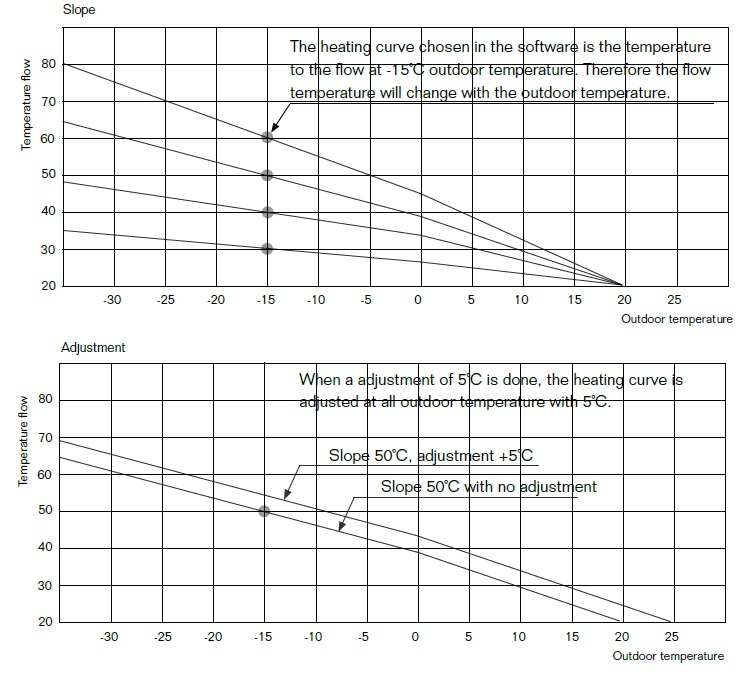
Choosing an Outdoor Reset Curve
Often there are more than a dozen curves to choose from. There is inherently some uncertainty in choosing a curve. One could argue that choosing a curve is part art and part science. The main objective is to find a curve that will work for the building, and that leaves some room for error. Finding that a curve is not steep enough, for example, is only going to be discovered when it’s really cold out. This is not a good result. Yet by choosing a curve that’s steeper than necessary, some system efficiency is sacrificed.
Once the system is set up, the chosen curve is usually not changed more than once or twice, if at all, so there’s not much in the way of “fine-tuning”. Curve adjustments are only made after the fact, based on tenant complaints. If the curve is too steep, tenants will not complain, yet efficiency is sacrificed.
[Note that steam systems use outdoor reset, but don’t work exactly like this. Read about steam systems here: A Modern Innovation for Improving the Efficiency of Steam Heating Systems]
Upgrading from Outdoor Reset to Leanheat AI
Among the factors that can be used to improve system efficiency is a group of building-specific factors such as how a building reacts to sun (e.g. amount of sunshine, time of day and time-of-year), wind (speed and direction), and “thermal inertia”, how a building responds to the heating system. Other important factors that are accounted for are individual unit temperatures, particularly those units farthest from the heat source. What’s needed to account for all these factors is energy intelligence software using algorithms that learn and adapt.
Leanheat AI actually takes into account all these extra factors using local weather forecasts, plus in-unit temperatures and humidity levels that are gathered by strategically placed sensors through cellular IoT technology. Without human intervention, a dynamic heating curve unique to the building is created. Boiler temperatures are controlled better, so there’s none of the typical large buffer that’s always been a necessary part of outdoor reset-controlled systems. As a result, the heating system runs more efficiently. In Finland, where Leanheat was first introduced, efficiency improvements of 10-20% have been realized.
An added benefit has been lower technical maintenance costs, such as from identifying and correcting housing units where climate control is problematic.
Back to top of post
Yesterday’s state-of-the-art steam heating systems will benefit from an upgrade to the innovative heating technology developed by Leanheat. This technology lowers energy use and costs. It does this by getting steam heating systems to run more efficiently.
Unlike hydronic systems which can easily regulate supply temperatures, steam systems always boil water to make steam. Making steam from hot water requires what’s known as a phase change (liquid to gas). Boiling water through this phase change requires a lot of extra energy*, so to wasting the energy, it’s important to limit the amount of steam produced to as close to what’s necessary to maintain comfort as possible. Steam systems are very sensitive to systemic heat loss because there’s a high temperature difference between the steam and the much lower temperatures around the system. Latent heat loss is costly, and drags down system efficiency to a much greater degree than is the case in the aforementioned hydronic systems, for example. For larger steam systems, there’s also an energy consuming vacuum pump that runs to distribute the steam. So the overall energy footprint of these systems is high.
Steam systems as they were initially constructed contained only passive energy saving technology. They relied on pipe insulation and good boiler design. But because getting even a little bit of heat through the building requires expending a lot of energy, any cycling on and off, plus overshoot effects lead to very inefficient operation.
Today’s steam systems typically operate with the first generation of active efficiency improvements. Outdoor temperature, together with a heating curve are used to limit the amount of time the boiler produces steam. For example, milder days require less heat, so by using the outdoor temperature as a factor to limit the time that steam is produced in each cycle, the costly waste of latent heat (see below) that results from overshoot (and thus overheated rooms and opening of windows) is partially avoided. The downside of this control technology, outdoor reset, is that it’s not able to account for outdoor temperature changes ahead of time, so a conservative buffer is required, which has a cost in lower efficiency.
What Leanheat technology does is take this concept of active energy saving quite a bit further, with more and better factors used to determine the amount of steam produced by the boilers. For example, rather than base the heat production of a long-lag heating system on the outdoor temperature right now, Leanheat factors in where the outdoor temperature is going (based on weather data), solar effects (e.g. expected sunshine or cloud cover), windchill effects, and so on. It also factors in how quickly room temperatures change when the boiler is running.
As a result of the Leanheat upgrade, less of a temperature buffer is required, and temperatures are more consistently comfortable throughout the building. The system also runs more efficiently, lowering costs.
More Reading
Read more about this topic in the blog post on outdoor reset here, and in the context of a building’s Unique Energy Fingerprint here.
And how lower energy costs effect property values here.
*It takes about 8,000 BTUs of energy to turn a gallon of boiling water into steam. An 80% efficient steam boiler would require over 10,000 BTU to make steam from a gallon of boiling water. The energy in the steam, know as latent heat, is given off as it condenses in the pipes and radiators.
Back to top of post
Outdoor reset technology, which bases operational temperatures on the outdoor temperature, is going to be eclipsed by innovative control technologies that can utilize more factors. As an efficiency solution, outdoor reset is a step above older technologies that use no external factors for achieving a measure of system efficiency, but there are plenty of external factors that, if taken into account, would improve efficiency even more. Information about energy intelligence software that accounts for these factors follows below, but first a review of outdoor reset.
Outdoor reset is a technology that matches up heating and cooling temperatures with corresponding outdoor temperatures. The purpose of this match-up is to increase efficiency by lowering systemic losses of energy that naturally occur from the production and distribution of thermal energy.
Here’s how outdoor reset works. Heating curves are shown in the image below. One of the curves is chosen manually by an installer or commissioning agent. The colder the outside temperature, the hotter the water that’s produced (or the longer the system runs, in the case of steam systems). The heating curve slope is chosen manually (top image) and the level of the slope is also chosen (2nd image).

Choosing an Outdoor Reset Curve
Often there are more than a dozen curves to choose from. There is inherently some uncertainty in choosing a curve. One could argue that choosing a curve is part art and part science. The main objective is to find a curve that will work for the building, and that leaves some room for error. Finding that a curve is not steep enough, for example, is only going to be discovered when it’s really cold out. This is not a good result. Yet by choosing a steeper than necessary curve, some system efficiency is sacrificed.
Once the system is set up, the chosen curve is usually not changed more than once or twice, if at all, so there’s not much in the way of “fine-tuning”. There’s just too much uncertainty for any one person or team to deal with.
Upgrading from Outdoor Reset to Leanheat AI
Among the factors that can be used to improve system efficiency is a group of building-specific factors such as how a building reacts to sun (e.g. amount of sunshine, time of day and time-of-year), wind (speed and direction), and thermal inertia. Other important factors that are accounted for are individual unit temperatures, particularly those units farthest from the heat source. What’s needed to account for all these factors is energy intelligence software using algorithms that learn and adapt.
Leanheat AI actually takes into account all these extra factors and creates, without human intervention, a heating curve unique to the building. As a result, the heating system runs more efficiently. In Finland, where Leanheat was first introduced, efficiency improvements of 10-20% have been realized.
An added benefit has been lower technical maintenance costs, such as from identifying and correcting housing units where climate control is problematic.
Back to top of post
Cutting energy costs has many benefits, not the least of which is increasing property values. The example below shows the effects on property values for a $10,000 cut in energy costs. If you consider that many properties can have their costs cut by some multiple of that figure, it’s clear that building (or business) valuations can be increased a great deal.
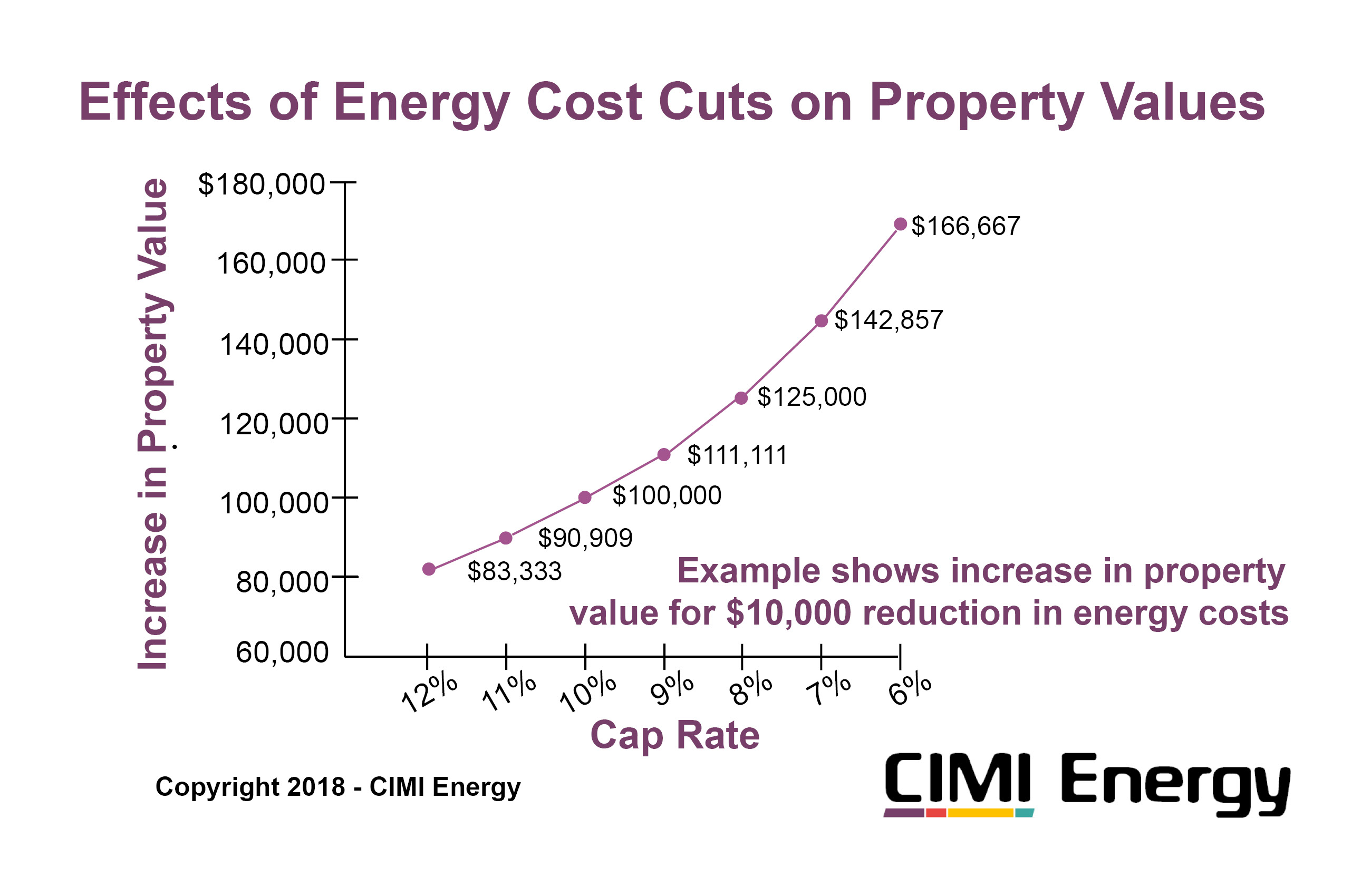
Investment Payback Considerations
For anyone considering the possibility of selling their property or business, the valuation should be factored into the payback equation. That is, even if a sale were contemplated for as little as one year out, an investment in energy cost cutting technology can make good sense even though the investment exceeds the returns on energy savings in that first year. That’s because the investment is not just lowering annual expenses, it’s also increasing the valuation by some multiple of that expense reduction. In other words, the investment results in a positive net present value.
Property Taxes
Another benefit of cutting energy costs is that the benefits over costs go directly to the bottom line. There should be little to no effect on property taxes because the added property valuation from the cost cuts would not be seen until the building or business is sold. In the meantime, energy cost savings accrue for the entire time that the asset upgrade is in place.
Back to top of post




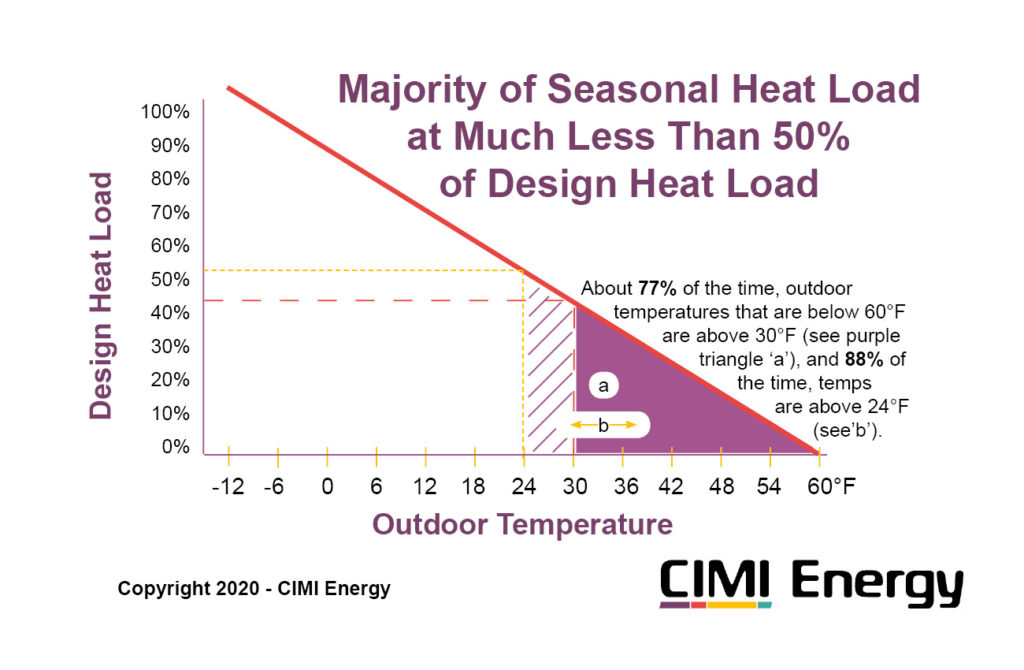
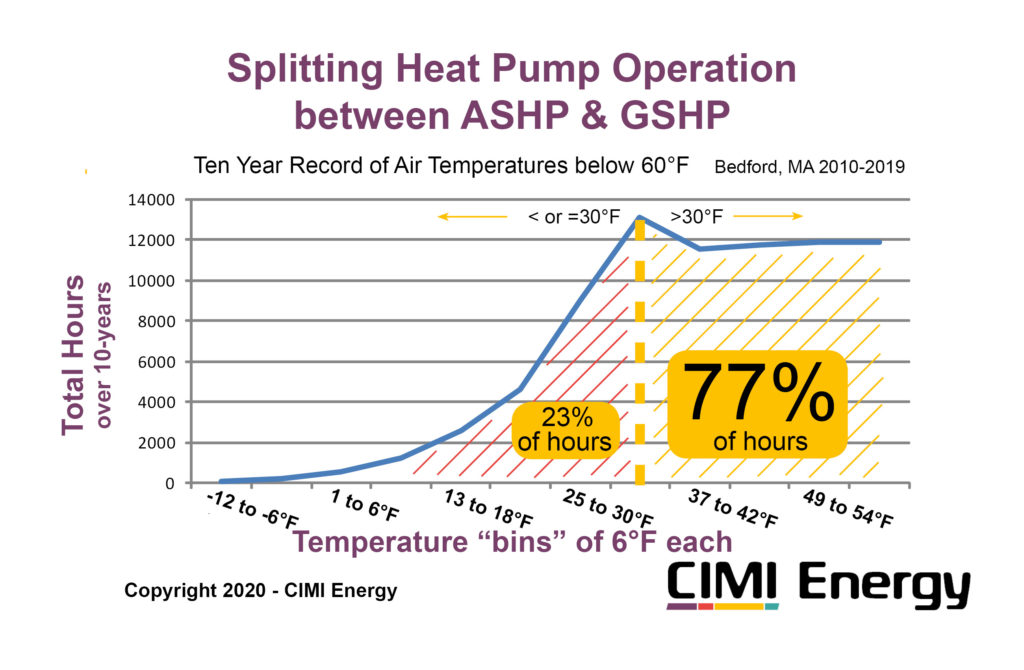
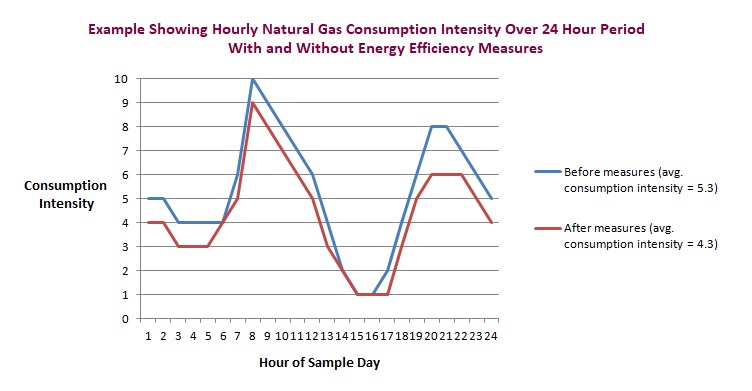
 The example shows the exact same consumption over the 24 hour period. The only difference between the two is that the red line is flatter, spreading out the demand, and maxing out at 50 therms/hour, a 17% reduction from the 60 therm/hour peak.
The example shows the exact same consumption over the 24 hour period. The only difference between the two is that the red line is flatter, spreading out the demand, and maxing out at 50 therms/hour, a 17% reduction from the 60 therm/hour peak. 
 road. You see a sign that says “Stop Ahead”. This is an opportunity to be proactive. You can take your foot off the accelerator and let the momentum of the car carry you forward to the stop line. That’s proactive and saves a little bit of energy. Now imagine you’re on a highway and you see a sign that says “Exit Right 1 Mile”. If that’s your exit, you can look for a good opportunity to move over to the right lane. That’s also being proactive. A third example is when you drive with your high beams on at night, you’re gaining more “visual data”; you can be more proactive in dealing with upcoming road hazards.
road. You see a sign that says “Stop Ahead”. This is an opportunity to be proactive. You can take your foot off the accelerator and let the momentum of the car carry you forward to the stop line. That’s proactive and saves a little bit of energy. Now imagine you’re on a highway and you see a sign that says “Exit Right 1 Mile”. If that’s your exit, you can look for a good opportunity to move over to the right lane. That’s also being proactive. A third example is when you drive with your high beams on at night, you’re gaining more “visual data”; you can be more proactive in dealing with upcoming road hazards. 

